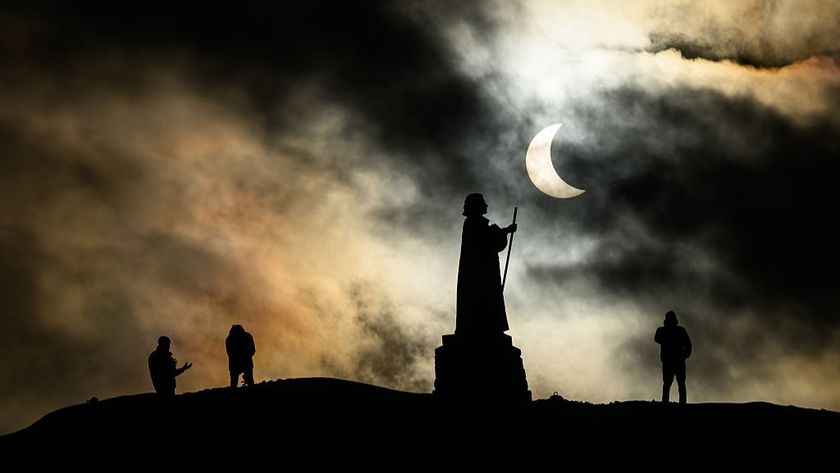The 7 Strangest Asteroids: Weird Space Rocks of the Solar System

This week, NASA's Dawn spacecraft will rendezvous with the asteroid Vesta. This will be our best look yet at an asteroid, and what the probe digs up could help scientists answer several questions about this and the hundreds of thousands of asteroids that populate the solar system.
Most asteroids, including Vesta, reside in the doughnut-like ring of the main asteroid belt that peppers the space between Mars and Jupiter. Other asteroids whirl in tight circles closer to the sun than the Earth, while a large number of them share planets' orbits. Not all asteroids are so happy to stay put, though: Some asteroids' orbits take them on planet-crossing swings through the inner solar system.
Given this variety of asteroids, some notably strange ones have popped up over our two centuries-plus of observations since the first asteroid, Ceres, was spotted in 1801.
In honor of Dawn's historic mission, which arrives at Vesta in the early morning hours of Saturday (July 17 EDT), here are seven of the solar system's strangest asteroids. (Note that space rocks out beyond the orbit of Jupiter, although somewhat asteroidal in nature, are classified as different bodies, and so we'll leave those alone for now.) [Photos of Asteroid Vesta and NASA's Dawn]

Ceres: A water-logged sphere?
The biggest asteroid by far is Ceres — which explains why it was discovered first — and it makes up about a third of the asteroid belt's mass. The object is so hefty that it's the only asteroid that has the gravitational strength to pull itself into a sphere.
On account of this roundness, Ceres is also considered a "dwarf planet," a designation it shares with four other objects in the solar system, including Pluto.
Get the Space.com Newsletter
Breaking space news, the latest updates on rocket launches, skywatching events and more!
After scoping out Vesta, the Dawn spacecraft will journey on to Ceres, arriving in 2015. Once there, the spacecraft will gather data to help scientists learn more about Ceres' composition. The object is probably the "wettest" asteroid, with large stores of water in its interior as ice, though also possibly as a liquid layer beneath the surface.

Baptistina: The mother of the dinosaur killer
It's a name that, had they survived into modern day, dinosaurs (intelligent ones with language, at least) would curse: Baptistina.
Baptistina is the name of one of the youngest families of asteroids in the asteroid belt.
(Families of asteroids are swarms of objects that share orbital characteristics, and are often named after their most prominent member.)
According to computer models, Baptistina and its swarm were spawned some 160 million years ago by a smashup between a 37-mile-wide body (60 kilometer) body and another object about 106 miles (170 kilometers) in diameter. That cataclysm created hundreds of large objects, some of which then drifted into a collision course with Earth.
One or several of these rocky shards of shrapnel then plowed into our planet 65 million years ago and helped doom the dinosaurs. The impact gouged out the Chicxulub crater, now buried by the Yucatan peninsula and the Gulf of Mexico. [What If a Giant Asteroid Didn't Wipe Out the Dinosaurs?]
The 100-million-year Baptistina barrage did not spare the moon, either. A meteorite scooped out the giant Tycho crater about 109 million years ago.

Kleopatra: A metal dog bone — with moons!
Many asteroids, believe it or not, have a moon, and some even sport two satellites. Kleopatra has two moons, which were named Alexhelios and Cleoselene earlier this year. To boot, the metallic asteroid has an unusual dog-bone shape.
The asteroid is roughly 135 by 58 by 50 miles (217 by 94 by 81 kilometers) in length, height and width. Its moons Alexhelios and Cleoselene are, respectively, about 3 miles (5 kilometers) and 1.9 miles (3 kilometers) in diameter.

Hektor, the biggest Trojan
Like Kleopatra, Hektor is very elongated, with length and width dimensions of approximately 230 by 124 miles (370 by 200 kilometers). Hektor has a moon as well. Unlike Kleopatra, however, Hektor is not found in the main asteroid belt; instead, the dark, reddish body dominates as the biggest of Trojan asteroids stuck in Jupiter's orbit.
These rocks lurk in what are known as the L4 and L5 Lagrangian points — two of the five zones in an orbit where the gravity of two bodies (in this case, Jupiter and the Sun) balances out. L4 and L5 lie ahead and behind, respectively of Jupiter.
In reference to the combatants in the ancient poet Homer's epic Iliad, the L4 asteroids are known as the Greek camp and the L5 group is the Trojan camp. Although named for the Trojan hero, Hektor is actually in the Greek camp.

Themis: Icy giver of life?
Themis, a large main belt asteroid, stands out as the first and only asteroid known thus far to have ice on its surface.
In 2009, observations in infrared light confirmed the presence of this ice, as well as carbon-containing, or organic, molecules.
These characteristics make the icy asteroid Themis and similar bodies called main belt comets good candidates for having delivered water and carbon — some of the ingredients of life — to the surface of a young, hot, dried-out Earth some four billion years ago.
Toutatis: A tumbling dumbbell
Named after a Celtic god, the asteroid Toutatis is one of the oddest space rocks. Instead of rotating in an orderly fashion about an axis, the double-lobed object chaotically tumbles. This unpredictable movement partially derives from Toutatis being composed of two bodies barely in contact with each other and from the influences of both Earth and Jupiter's gravity.
Toutatis' path through the solar system has it sweep close to Earth, but because the asteroid's orbit is chaotic, its exact path — and how close it might come to us — centuries from now cannot be well predicted.
Like some other asteroids, Toutatis is said to be a like a "rubble pile" — fragments of rock that have gravitationally come back together after a collision, but left many gaps between them.

Apophis: The alleged Doomsday rock
Toutatis has made some close shaves to Earth, and passed within 1,000,000 miles (1.61 million kilometers) of Earth, or about four Moon distances, back in 2004. Yet some rocks have made notably closer passes, and the one that has most alarmed astronomers and the public alike is Apophis. [Doomsday Facts (and Fictions)]
Discovered in 2004 and named after the Greek word for the evil Egyptian god of darkness, Apophis will return to the neighborhood in 2029. At the time, scientists calculated that its impacting Earth on that future pass were as high as 1 in 40, but subsequent measurements have now relegated that possibility to almost nil.
Panic peaked in December 2004, and Apophis achieved a ranking of 4 on the Torino scale, the 10-point scale that rates the risk of an object colliding with Earth (10 being an unquestioned apocalypse). Although Apophis is now deemed zero for its 2029 pass, it will zoom a mere 18,600 miles (30,000 kilometers) above Earth's surface.
A number of these other so-called Near Earth Objects, or NEOs, have yet to be cataloged. Yet some that have pose no threat, and benignly share Earth's orbit. At least four examples exist of asteroids that follow Earth in horseshoe-shaped orbits; a new one, designated 2010 SO16, was found earlier this year.
This story was provided by Life's Little Mysteries, a sister site to SPACE.com. Follow Life's Little Mysteries on Twitter @llmysteries, then join us on Facebook.
Join our Space Forums to keep talking space on the latest missions, night sky and more! And if you have a news tip, correction or comment, let us know at: community@space.com.

Adam Hadhazy is a contributing writer for Live Science and Space.com. He often writes about physics, psychology, animal behavior and story topics in general that explore the blurring line between today's science fiction and tomorrow's science fact. Adam has a Master of Arts degree from the Arthur L. Carter Journalism Institute at New York University and a Bachelor of Arts degree from Boston College. When not squeezing in reruns of Star Trek, Adam likes hurling a Frisbee or dining on spicy food. You can check out more of his work at www.adamhadhazy.com.












